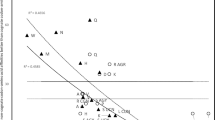Abstract
Imposing a minimum principle in the framework of the so called crystal basis model of the genetic code, we determine the structure of the minimum set of 22 anticodons which allows the translational-transcription for animal mitochondrial code. The results are in very good agreement with the observed anticodons. Then, we analyse the evolution of the genetic code, with 20 amino acids encoded from the beginning, from the viewpoint of codon-anticodon interaction. Following the same spirit as above, we determine the structure of the anticodons in the Ancient, Archetypal and Early Genetic codes. Most of our results agree with the generally accepted scheme.
Similar content being viewed by others
References
P. F. Agris, “Decoding the genome: a modified view,” Nucl. Acids Res. 32, 223–238 (2004).
M Carullo and X. Xia, “An extensive study of mutation and selection on wobble nucleotide in tRNA anticodons in fungal mitochondrial genomes,” J.Mol. Evol. 66, 484–493 (2000).
F. H. C. Crick, “Codon-anticodon pairing: the wobble hypothesis,” J.Mol. Evol. 19, 548–555 (1966).
B. Dragovich and A. Yu. Dragovich, “A p-adic model of DNA sequence and genetic code,” p-Adic Numbers Ultr. Anal. Appl. 1 34–41, (2009).
L. Frappat, A. Sciarrino and P. Sorba, “A Crystal base for the genetic code,” Phys. Lett. A 250, 214–221 (1998).
L. Frappat, A. Sciarrino and P. Sorba, “Crystalizing the genetic code,” J. Biol. Phys. 27, 1–34 (2001).
P. G. Higgs, D. Jameson, H. Jow and M. Rattray, “The evolution of tRNA-L genes in animal mitochondrial genomes,” J.Mol. Evol. 57, 435–445 (2003).
Yu Hong and Li Qi, “Mutation and selection on the wobble tRNA anticodons inmarine bivalve mitochondrial genomes,” PLoS ONE 6, e1617 (2011).
S. Itzkovitz and U. Alon, The genetic code is nearly optimal for allowing additional informationwithin proteincoding sequences, Genome Res. 17, 405–412 (2007).
T. H. Jukes, How many anticodons ?,” Science 198, 319–320 (1977).
T. H. Jukes, Evolution of the amino acid code: inference from mitochondrial codes,” J.Mol. Evol. 19, 219–225 (1983).
M. Kashiwara, Crystalizing the q-analogue of universal enveloping algebras,” Commun. Math. Phys. 133, 249–260 (1990).
R. D. Knight, S. I. Freeland and L. F. Landweber, Rewiring the keyboard: evolvability of the genetic code,” Nature Rev. Genet. 2, 49–58 (2001).
V. I. Lim and J. S. Curran, “Analysis of codon-anticodon interactions within the ribosome provides new insights into codon reading and the genetic code structure,” RNA 7, 942–957 (2001).
Y. Nakamura, T. Gojobori and T. Ikemura, Nucl. Acids Res. 26, 334 (1998). Codon Usage Database: http://www.kazusa.or.jp/codon.
S. L. Nikolaeva and T. Wilhelm, “The purine-pyrimidine classification scheme reveals new patterns in the genetic code,” http://www.imb-jena.de/~sweta/genetic_code_and_evolution/Finalpaper.pdf (2005).
S. Nikolajewa, M. Friedel, A. Beyer and T. Wilhelm, “The new classification scheme of the genetic code, its early evolution and tRNA usage,” J. Bioinf. Comp. Biol. 4, 609–620 (2006).
T. Ohama, Y. Inagaki, Y. Bessho and S. Osawa, “Evolving genetic code,” Proc. Jpn. Acad., Ser. B 84, 58–74 (2008).
D.W. Schultz and M. Yarus, “On malleability in the genetic code,” J.Mol. Evol. 42, 597–601 (1996).
A. Sciarrino, “A mathematical model accounting for the organization in multiplets of the genetic code,” BioSystems 69, 1–13 (2003).
A. Sciarrino and P. Sorba, “Aminimum principle in codon-anticodon interaction,” BioSystems 107, 113–119 (2012).
A. Sciarrino and P. Sorba, “Codon-anticodon interaction and the genetic code evolution,” BioSystems 111, 175–180 (2013).
M. Sprinzl, C. Horn, M. Brown A. Loudovitch and S. Steinberg, “Compilation of tRNA sequences and sequences of tRNA genes,” Nucl. Acids Res. 26, 148–153 (1998); http://www.staff.uni-bayreuth.de/~btc914/search/index.html.
T. Wilhelm and S. Nikolajewa, “A new classification scheme of the genetic code,” J. Mol. Evol. 59, 598–605 (2004).
T. Yamashita and O. Narikiyo, “Codon capture and ambiguous intermediate scenarios of genetic code evolution,” http://arxiv.org/pdf/1110.5123.pdf (2011).
Author information
Authors and Affiliations
Corresponding author
Additional information
The text was submitted by the authors in English.
Rights and permissions
About this article
Cite this article
Sciarrino, A., Sorba, P. Crystal basis model: Codon-Anticodon interaction and genetic code evolution. P-Adic Num Ultrametr Anal Appl 6, 257–274 (2014). https://doi.org/10.1134/S2070046614040013
Received:
Published:
Issue Date:
DOI: https://doi.org/10.1134/S2070046614040013




